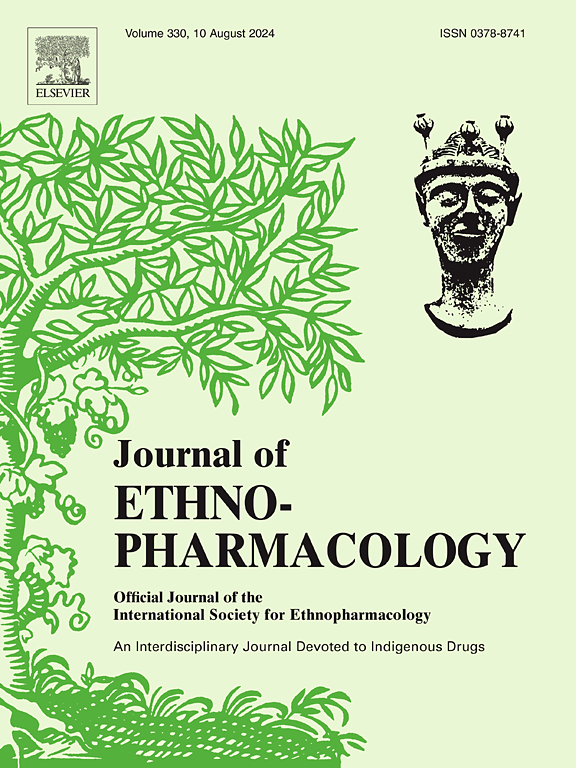黄芪-姜黄对通过EGFR/AKT/mTOR通路抑制肝癌,并通过HIF-1α/HO-1/GPX4轴诱导脂质过氧化相关铁凋亡
IF 4.8
2区 医学
Q1 CHEMISTRY, MEDICINAL
引用次数: 0
摘要
黄芪-姜黄对(ACHP)源于著名的中医典籍《益血中中参西律》,其中两种草药配对形成临床常用的用于治疗消化系统肿瘤,如肝细胞癌(HCC)的中药复方。尽管ACHP在中国已有数千年的遗传历史,但其对抗HCC的机制尚不清楚。本研究旨在评价乙酰胆碱治疗肝癌的效果并探讨其作用机制。方法采用肿瘤体积、脏器指数、H&;E染色、肝肾因子等方法评价ACHP在体内抗肝癌的疗效和安全性。采用UPLC-Q-TOF-MS/MS对血清ACHP代谢产物进行鉴定。通过转录组学、网络药理学和分子对接等手段筛选了ACHP抗HCC的关键靶点和潜在机制。采用MTT法、菌落形成法和特异性检测试剂盒评价含achp血清对肝癌细胞铁下垂的影响及诱导作用。免疫组化检测体内凋亡相关蛋白和途径的表达。结果与单独使用的两种中药相比,achp能显著抑制肿瘤的增殖,且具有良好的安全性。在正离子和负离子模式下共鉴定出75种血清代谢物。转录组学结果显示,铁下垂在ACHP抗hcc过程中起关键作用。网络药理学和分子对接结果提示,ACHP的抗hcc作用可能与EGFR/AKT/mTOR通路和HIF-1α/HO-1/GPX4轴有关。体外和体内实验进一步证明,ACHP通过EGFR/AKT/mTOR通路抑制肿瘤信号通路,同时通过HIF-1α/HO-1/GPX4轴诱导脂质过氧化相关的铁下垂,从而抑制HepG2细胞增殖和HCC小鼠肿瘤生长。结论achp通过EGFR/AKT/mTOR通路抑制癌性信号通路,并通过HIF-1α/HO-1/GPX4轴诱导脂质过氧化相关的肝癌铁下垂,发挥其作用。这项系统的研究建立了从化合物鉴定到机制验证的连贯药理学链,突出了ACHP作为肝癌中靶向致癌信号网络的铁下垂诱导剂的治疗潜力。本文章由计算机程序翻译,如有差异,请以英文原文为准。

Astragali radix - Curcumae rhizoma herb pair suppresses hepatocellular carcinoma through EGFR/AKT/mTOR pathway and induces lipid peroxidation-related ferroptosis via HIF-1α/HO-1/GPX4 axis
Ethnopharmacological relevance
The Astragali Radix - Curcumae Rhizoma herb pair (ACHP) originated from the famous traditional Chinese medicine text “YiXueZhongZhongCanXiLu”, in which the two herbs were paired to form Chinese herbal compounds commonly used clinically for digestive system tumors, such as hepatocellular carcinoma (HCC). Although ACHP has been inherited for thousands of years in China, its mechanism against HCC remains unclear.
Aim of the study
The study aims to evaluate the effect and explore the mechanism of ACHP against HCC.
Methods
The efficacy and safety of ACHP against HCC in vivo were evaluated by tumor volume, organ index, H&E staining, hepatic and renal factors. The serum metabolites of ACHP were identified by UPLC-Q-TOF-MS/MS. The key targets and potential mechanisms of ACHP against HCC were screened by transcriptomics, network pharmacology and molecular docking. The effect and induction of ferroptosis of ACHP-containing serum on HCC in vitro was evaluated by MTT, colony formation assay and specific detection kits. The expression of ferroptosis-related proteins and pathways in vivo was detected by immunohistochemistry.
Results
ACHP significantly inhibited tumor proliferation compared to the two herbs used separately, and showed a favorable safety profile. A total of 75 serum metabolites were identified in both positive and negative ion modes. Transcriptomics results revealed that ferroptosis played a key role in the anti-HCC process of ACHP. Network pharmacology and molecular docking results suggested that the anti-HCC effect of ACHP may be related to EGFR/AKT/mTOR pathway and HIF-1α/HO-1/GPX4 axis. In vitro and in vivo experiments further demonstrated that ACHP suppressed oncogenic signaling via the EGFR/AKT/mTOR pathway while inducing lipid peroxidation-related ferroptosis through HIF-1α/HO-1/GPX4 axis, thereby inhibiting HepG2 cells proliferation and HCC mice tumor growth.
Conclusion
ACHP exerts its effects by suppressing oncogenic signaling through the EGFR/AKT/mTOR pathway and inducing lipid peroxidation-related ferroptosis in HCC via the HIF-1α/HO-1/GPX4 axis. This systematic investigation establishes a coherent pharmacological chain from compound identification to mechanism verification, highlighting ACHP's therapeutic potential as a ferroptosis inducer targeting oncogenic signaling networks in HCC.
求助全文
通过发布文献求助,成功后即可免费获取论文全文。
去求助
来源期刊

Journal of ethnopharmacology
医学-全科医学与补充医学
CiteScore
10.30
自引率
5.60%
发文量
967
审稿时长
77 days
期刊介绍:
The Journal of Ethnopharmacology is dedicated to the exchange of information and understandings about people''s use of plants, fungi, animals, microorganisms and minerals and their biological and pharmacological effects based on the principles established through international conventions. Early people confronted with illness and disease, discovered a wealth of useful therapeutic agents in the plant and animal kingdoms. The empirical knowledge of these medicinal substances and their toxic potential was passed on by oral tradition and sometimes recorded in herbals and other texts on materia medica. Many valuable drugs of today (e.g., atropine, ephedrine, tubocurarine, digoxin, reserpine) came into use through the study of indigenous remedies. Chemists continue to use plant-derived drugs (e.g., morphine, taxol, physostigmine, quinidine, emetine) as prototypes in their attempts to develop more effective and less toxic medicinals.
 求助内容:
求助内容: 应助结果提醒方式:
应助结果提醒方式:


